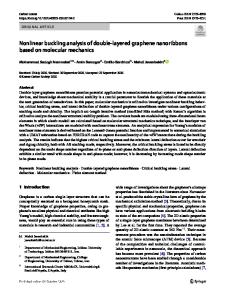Nonlinear Mechanical Properties of Graphene Nanoribbons
- PDF / 360,625 Bytes
- 7 Pages / 432 x 648 pts Page_size
- 106 Downloads / 363 Views
Nonlinear Mechanical Properties of Graphene Nanoribbons Qiang Lu and Rui Huang Department of Aerospace Engineering and Engineering Mechanics, University of Texas, Austin, Texas 78712, USA ABSTRACT Based on atomistic simulations, the nonlinear elastic properties of monolayer graphene nanoribbons under quasistatic uniaxial tension are predicted, emphasizing the effect of edge structures (armchair and zigzag, without and with hydrogen passivation). The results of atomistic simulations are interpreted using a theoretical model of thermodynamics, which enables determination of the nonlinear functions for the strain-dependent edge energy and the hydrogen adsorption energy, for both zigzag and armchair edges. Due to the edge effects, the initial Young’s modulus of graphene nanoribbons under infinitesimal strain varies with the edge chirality and the ribbon width. Furthermore, it is found that the nominal strain to fracture is considerably lower for armchair graphene nanoribbons than for zigzag ribbons. Two distinct fracture mechanisms are identified, with homogeneous nucleation for zigzag ribbons and edgecontrolled heterogeneous nucleation for armchair ribbons. INTRODUCTION Graphene ribbons with nanoscale widths (W < 20 nm) have been produced recently, either by lithographic patterning [1-3] or by chemically derived self assembly processes [4], with potential applications in nanoelectronics and electromechanical systems. The edges of the graphene nanoribbons (GNRs) could be zigzag, armchair, or a mixture of both [5]. It has been theoretically predicted that the special characteristics of the edge states leads to a size effect in the electronic state of graphene and controls whether the GNR is metallic, insulating, or semiconducting [5-8]. The effects of the edge structures on deformation and mechanical properties of GNRs have also been studied to some extent [9-18]. On one hand, elastic deformation of GNRs has been suggested as a viable method to tune the electronic structure and transport characteristics in graphene-based devices [15, 16]. On the other hand, plastic deformation and fracture of graphene may pose a fundamental limit for reliability of integrated graphene structures. The mechanical properties of bulk graphene (i.e., infinite lattice without edges) have been studied both theoretically [19-21] and experimentally [22]. For GNRs, however, various edge structures are possible [23, 24], with intricate effects on the mechanical properties. Ideally, the mechanical properties of GNRs may be characterized experimentally by uniaxial tension tests. To date however no such experiment has been reported, although similar tests were performed for carbon nanotubes (CNTs) [25]. Theoretically, previous studies on the mechanical properties of GNRs have largely focused on the linear elastic properties (e.g., Young’s modulus and Poisson’s ratio) [11-15]. While a few studies have touched upon the nonlinear mechanical behavior including fracture of GNRs [12, 13, 16], the effect of the edge structures in the nonlinear regime has not
Data Loading...











